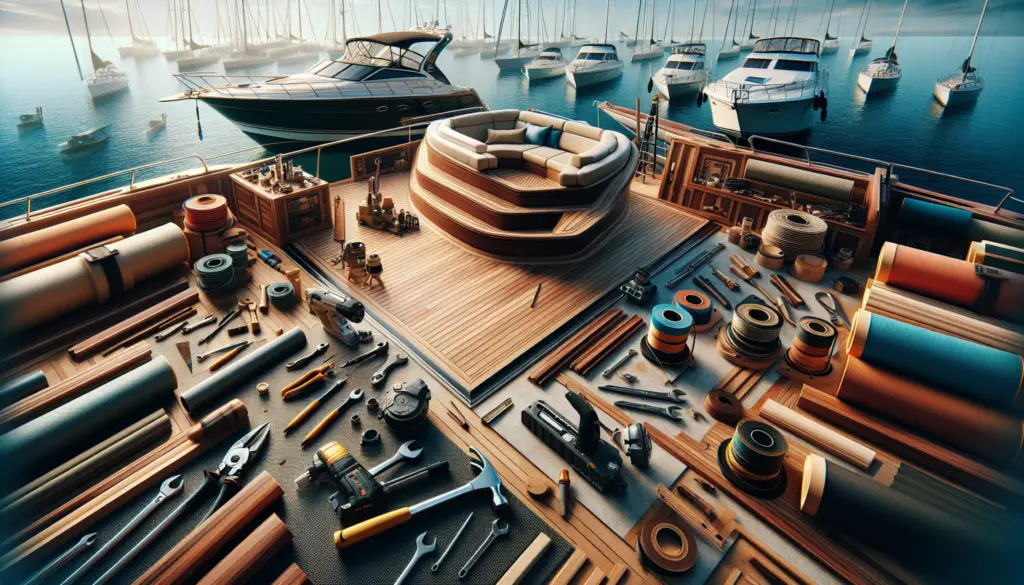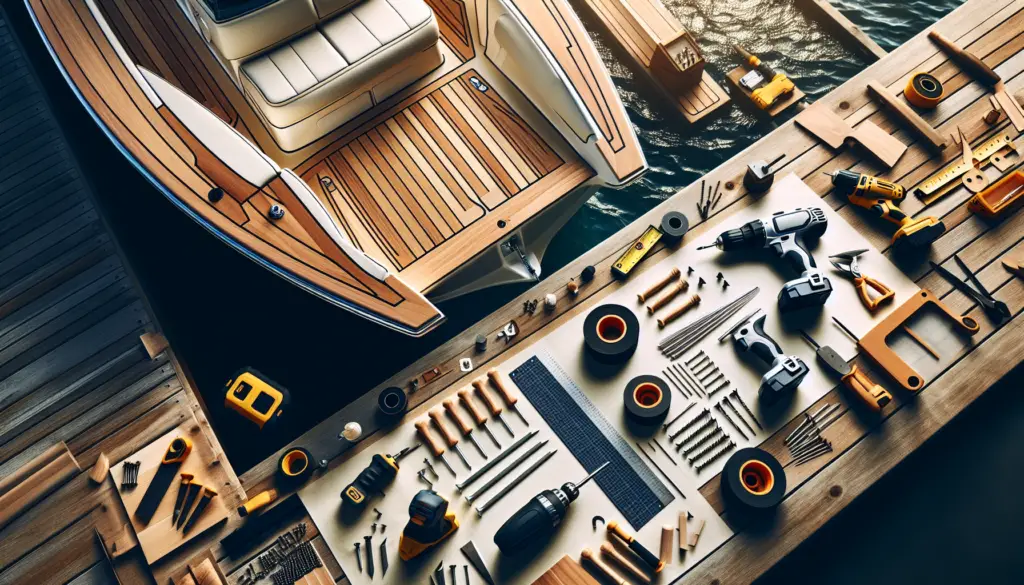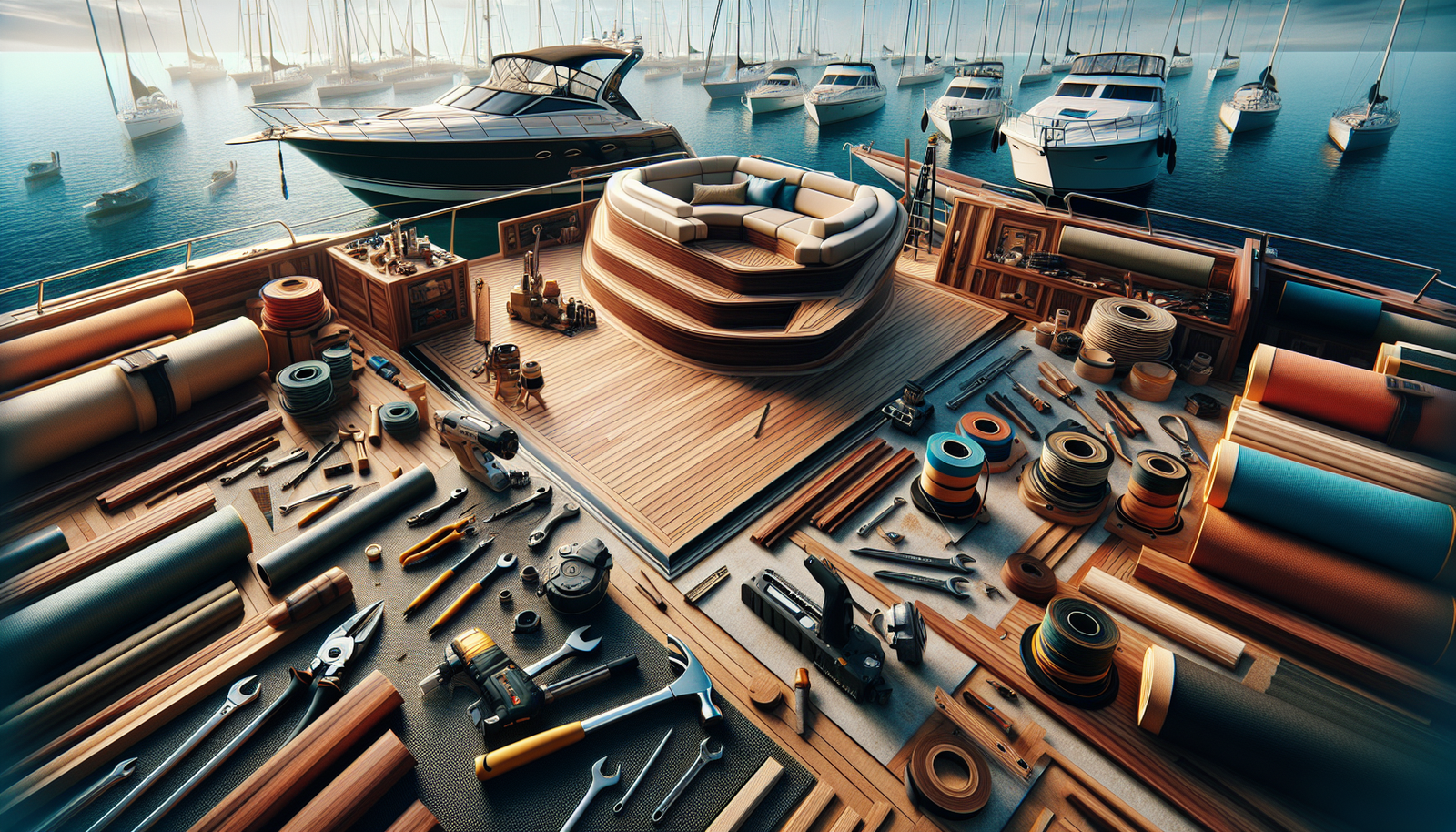Adding custom decking to your boat can transform the appearance and functionality of your vessel. Whether you’re a boating enthusiast looking to enhance your boat’s aesthetic appeal or a seasoned sailor seeking to improve traction and durability on your deck, this beginner’s guide will provide you with all the information you need to get started. From choosing the right materials to step-by-step installation instructions, read on to discover everything you need to know to create a custom deck that perfectly suits your boating needs.

Choosing the Right Materials
When it comes to adding custom decking to your boat, choosing the right materials is essential for achieving a durable and visually appealing result. There are various options available, including wood and non-wood materials. Understanding the benefits and drawbacks of each is crucial in making an informed decision.
Understanding Wood Options
Wood is a popular choice for boat decking due to its natural beauty and ability to withstand the harsh marine environment. Common wood options include teak, mahogany, and cedar. Teak is highly regarded for its durability, resistance to rot and insects, and attractive grain patterns. Mahogany, on the other hand, offers a rich and warm appearance, while cedar is known for its light weight and natural resistance to decay.
Considering Non-wood Options
While wood is a classic choice, there are also non-wood materials that can be used for boat decking. These alternatives often offer lower maintenance requirements and better resistance to moisture and UV damage. Synthetic options such as composite decking, PVC, and aluminum are gaining popularity. Composite decking is made from a blend of wood fibers and recycled plastic, providing a durable and eco-friendly choice. PVC decking is known for its low maintenance and slip-resistant properties, while aluminum decks offer exceptional durability and lightweight construction.
Evaluating Durability and Maintenance Requirements
When selecting the materials for your boat decking, it’s important to consider their durability and maintenance requirements. Wood decking requires regular sealing and refinishing to maintain its appearance and protect it from the elements. Non-wood options, on the other hand, generally require less maintenance and are more resistant to fading, rot, and warping. Assessing your priorities and available time for maintenance will help in making the right choice for your custom boat decking.
Taking Accurate Measurements
Before you dive into the installation process, taking accurate measurements of your boat’s deck is crucial for ensuring a precise fit of your custom decking. This step requires attention to detail and the use of specific tools.
Materials Needed for Measurement
To take accurate measurements, gather the necessary materials beforehand. You’ll need a tape measure, a straightedge or level, a pencil or pen, and a notepad or paper to record the measurements. Having these tools readily available will make the process smoother and more efficient.
Measuring the Boat’s Deck
Begin by measuring the length and width of your boat’s deck using the tape measure. It’s important to measure from the widest points to ensure the decking covers the entire surface. Record these measurements on your notepad or paper for reference during the installation process.
Considering Curved Areas
In addition to measuring the length and width, it’s essential to take into account any curved areas on your boat’s deck. To accurately measure these sections, use a flexible tape measure or tailor’s tape. Place the tape along the curve, following its shape, and record the measurements as needed. Taking precise measurements of curved areas will help in creating custom decking that fits seamlessly on your boat’s deck.

Preparing the Boat’s Surface
Properly preparing the boat’s surface is a crucial step in the custom decking installation process. This preparation ensures a clean and smooth foundation for the new decking material.
Removing Old Decking
If your boat has existing decking that needs to be replaced, start by removing it. Use a pry bar or screwdriver to gently lift and remove the old decking material. Take care not to damage the underlying structure of the boat during this process. Once the old decking is removed, thoroughly clean the surface to remove any remaining debris or adhesive residue.
Repairing Damaged Areas
While preparing the boat’s surface, closely inspect for any damaged areas that need repair. Repair any cracks, splits, or rotted sections using appropriate marine-grade epoxy or filler. Allow ample time for the repairs to fully cure and harden before proceeding to the next steps.
Cleaning and Sanding the Surface
After removing the old decking and repairing any damages, thoroughly clean the boat’s surface. Use a mild detergent, water, and a scrub brush to remove dirt, grease, and stains. Rinse the surface with clean water and allow it to dry completely. Once the surface is dry, sand it using a medium-grit sandpaper. Sanding helps to promote adhesion and create a smooth surface for the new decking material.
Designing the Deck Layout
Designing the deck layout is an exciting step in the boat decking installation process. It allows you to envision the final result and ensure effective utilization of space on your boat’s deck.
Considering Floating or Fixed Deck
One of the first decisions to make when designing your deck layout is whether you want a floating or fixed deck. A floating deck is not permanently attached to the boat but rather secured with brackets or other fasteners. This option offers flexibility and easy removal if desired. On the other hand, a fixed deck is permanently attached to the boat’s structure, providing stability and a more integrated look.
Planning Deck Segments
Once you’ve decided on the type of deck, plan the layout by dividing the deck into segments. Consider the different areas of your boat and how you intend to use the deck space. Common segments include a seating area, a cooking area, a storage area, or a relaxation zone. Be mindful of leaving enough space for easy movement and access to different parts of the boat.
Ensuring Adequate Drainage
Adequate drainage is crucial to prevent the accumulation of water on your boat’s deck. During the design phase, ensure that each deck segment has proper drainage channels or outlets. Incorporate sloping or angled surfaces to direct water towards these drainage points. Proper drainage will help maintain the longevity of the decking material and prevent any water-related issues.

Cutting and Shaping the Decking
Cutting and shaping the decking material is a critical step in custom boat decking installation. With the right tools and safety equipment, you can achieve precise cuts and create a deck that seamlessly fits your boat’s contours.
Preparing Tools and Safety Equipment
Before cutting and shaping the decking material, gather all the necessary tools and safety equipment. Depending on the material, you may need a circular saw, jigsaw, or router. Ensure that you have appropriate blades and bits for your chosen tools. Additionally, wear appropriate safety gear such as safety glasses, gloves, and a dust mask to protect yourself during the cutting and shaping process.
Cutting and Shaping Wood or Non-wood Materials
When cutting wood decking, measure and mark the desired dimensions on the material before using a circular saw or jigsaw to make the cuts. Take your time to ensure accuracy and use a guide or straightedge for straight cuts. For curved cuts, a jigsaw or router with an appropriate cutting bit can be used.
If you’re working with non-wood materials such as composite decking or PVC, follow the manufacturer’s instructions for cutting and shaping. Some materials may require specialized tools or techniques, so always refer to the guidelines provided.
Determining Fastener Placement
Besides cutting and shaping the decking, it’s essential to plan and determine the placement of fasteners. Whether you’re using adhesive or screws, make sure to place them strategically along the decking material to ensure a secure and stable installation. Avoid placing fasteners too close to the edges to prevent splitting or weakening of the decking material.
Installing the Decking
The installation process is where your custom boat decking starts to come to life. With the right adhesive or fasteners, precise measurements, and proper techniques, you can achieve a professional-looking installation.
Choosing the Right Adhesive or Fasteners
Selecting the appropriate adhesive or fasteners is crucial for installing the decking material securely. If you’ve opted for a floating deck, adhesive may be the preferred method. Choose a marine-grade adhesive that is compatible with your chosen material and follow the manufacturer’s instructions for application. For fixed decks, using screws or marine-grade stainless-steel nails is recommended.
Pre-drilling Holes
Before installing the decking material, pre-drill holes to prevent splitting or cracking. Use a drill bit with a diameter slightly smaller than the size of the screws or nails you plan to use. Pre-drilling ensures a clean and precise installation, especially when working with harder materials such as hardwood or composite decking.
Applying Adhesive or Installing Fasteners
Once you’ve prepped the boat’s surface and prepared the decking material, carefully apply the adhesive or install the fasteners. If using adhesive, spread it evenly on the surface, following the manufacturer’s recommended coverage. For fasteners, align the decking material with the pre-drilled holes and secure it firmly into place. Ensure that the decking fits snugly and any excess adhesive or fastener heads are wiped away.

Sealing and Finishing the Deck
To protect your boat’s custom decking and enhance its lifespan, sealing and finishing are essential steps. Depending on the material, you may need to apply a sealant, paint, stain, or other protective coatings.
Sealing Wood Decking
If you’ve opted for wood decking, sealing is crucial to protect it from moisture, UV damage, and other environmental factors. Choose a high-quality marine-grade sealant that is suitable for your specific type of wood. Apply the sealant according to the manufacturer’s instructions, ensuring even coverage and attention to any exposed edges or end grain.
Applying Paint or Stain
Paint or stain can be applied to both wood and non-wood decking materials for added protection and aesthetic appeal. For wood decking, select a marine-grade paint or stain that is designed for outdoor use. Apply multiple coats as necessary, allowing sufficient drying time between each coat. Non-wood materials may require specific paints or coatings, so refer to the manufacturer’s recommendations for best results.
Considering Non-slip Surface Options
To improve safety on your boat’s deck, consider incorporating non-slip surfaces. Non-slip paint, adhesive strips, or textured coatings can be applied to the decking material to provide better traction, especially in wet or slippery conditions.
Adding Additional Features
Once the decking installation and finishing are complete, you can further enhance your boat’s deck by incorporating additional features that suit your needs and preferences.
Installing Railings
If your boat’s deck requires added safety or aesthetics, consider installing railings. Railings provide support and help prevent accidents while enhancing the overall appearance of the deck. Choose a railing system that complements your decking material and complements the design of your boat.
Incorporating Lighting
To create ambiance and improve visibility on your boat’s deck, incorporate lighting features. LED lights, solar-powered lanterns, or recessed lighting can be strategically placed to provide both function and style. Consider different lighting options, such as pathway lights or accent lights, to create a welcoming and inviting atmosphere.
Integrating Storage Options
Boats often have limited storage space, so integrating storage options in your custom deck can be a game-changer. Built-in compartments, under-deck storage, or cleverly designed seating with hidden compartments can provide convenient storage solutions while maximizing the use of space.

Maintaining and Upkeeping the Deck
To ensure the longevity and optimal performance of your custom boat decking, regular maintenance and upkeep are necessary. Implementing a routine cleaning and inspection schedule, addressing any damages promptly, and protecting against the elements are key considerations.
Regular Cleaning and Inspection
Regularly clean your boat’s deck to prevent the accumulation of dirt, debris, and moisture. Use a mild detergent or specialized boat deck cleaner and a soft brush to scrub away any stains or grime. Rinse thoroughly with clean water and allow the deck to dry completely. Additionally, conduct routine inspections to identify any signs of wear, damage, or loose fasteners. Promptly address these issues to prevent further degradation or safety hazards.
Repairing Damages
If you notice any damages during your inspections or regular use, it’s crucial to address them promptly. Repair any cracks, chips, or splintered areas to maintain the integrity of the deck material. Refer to the manufacturer’s recommendations or seek professional assistance when necessary.
Protecting Against Elements
To protect your boat’s custom decking from the elements, implement preventive measures. Consider using a boat cover when the vessel is not in use to shield the decking from direct sunlight, rain, and other weather conditions. Additionally, apply a protective coating or sealant regularly to repel water and minimize damage from exposure to UV rays.
Adhering to Safety Guidelines
When undertaking any customization or modification on your boat, adhering to safety guidelines is of utmost importance. Ensuring proper weight distribution, securing loose objects, and following fire safety precautions should be top priorities.
Ensuring Proper Weight Distribution
Maintaining proper weight distribution is essential for the stability and safety of your boat. Custom decking should be installed in a way that does not compromise the vessel’s balance. Be mindful of the weight of the decking material itself and distribute it evenly to prevent any tilting or instability.
Securing Loose Objects
When designing and installing your custom boat decking, ensure that all objects, equipment, and accessories are properly secured. Loose objects can pose hazards, especially in rough waters or during sudden movements. Utilize storage compartments, tie-downs, or other securing methods to keep everything in place.
Following Fire Safety Precautions
Boats are susceptible to fire hazards, and proper fire safety precautions should always be followed. When customizing your boat’s deck, be mindful of the materials used and their fire ratings. Install fire extinguishers in accessible locations and ensure that they are in good working condition. Familiarize yourself with emergency procedures and have an emergency plan in place.
By following these safety guidelines, you can enjoy your boat’s custom decking while prioritizing your own and others’ safety.
Adding custom decking to your boat can transform its appearance and functionality. With the right materials, accurate measurements, proper surface preparation, thoughtful design, precise cutting and shaping, and careful installation, you can achieve a beautiful and functional deck. Don’t forget to seal and finish the deck, consider additional features, and prioritize regular maintenance to ensure its longevity. Always keep safety in mind, following guidelines and taking precautions for a worry-free boating experience. So, get ready to embark on your boating adventures with a customized deck that truly enhances your boat!

